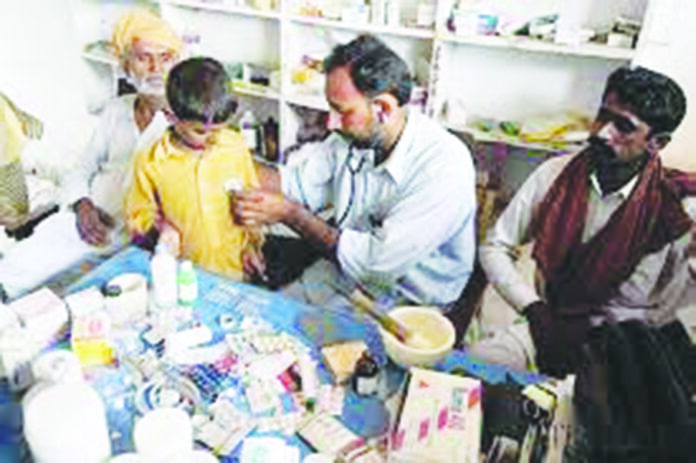Healthcare has always been a huge issue in Pakistan. With its huge population the economy struggles to create new facilities, especially in the rural areas. One of the most evident manifestations of the scarcity of healthcare in Pakistan is the inadequate healthcare infrastructure, particularly in rural areas. While urban centres have a relatively better distribution of healthcare facilities, rural regions face a stark lack of healthcare infrastructure. Many villages and remote areas lack even the most basic healthcare centres, making access to medical services a daunting challenge for residents.
Furthermore, transportation and distance add another layer of complexity to the problem. The necessity of traveling long distances to reach the nearest healthcare facility can be both costly and time-consuming. The underdeveloped road infrastructure in some regions further compounds these difficulties, making it nearly impossible for individuals to access medical assistance in emergencies.
In addition to infrastructure, Pakistan faces a dire shortage of healthcare professionals, including doctors, nurses, and support staff. This scarcity is especially pronounced in rural areas, as medical practitioners often prefer urban settings due to better career opportunities and living conditions. As a result, rural communities are left underserved and struggle to access essential healthcare services.
The scarcity of healthcare professionals also leads to an overburdened healthcare system in urban centres, where large populations rely on a limited number of medical experts. This results in long waiting times, a reduced quality of care, and, in some cases, inadequate medical attention.
Furthermore, financial barriers pose significant hurdles to accessing healthcare in Pakistan. The country’s high poverty rate, coupled with a large population, means that a considerable portion of the populace cannot afford even basic medical services. Private healthcare in Pakistan is often costly, while public healthcare facilities, although more affordable, may face shortages of resources and long waiting times. The lack of comprehensive health insurance further exacerbates financial barriers to healthcare access. Without insurance coverage, individuals and families must bear the full burden of medical expenses, which can push many into financial distress. This financial strain often deters people from seeking healthcare, even when they require urgent medical attention.
Everyone involved in the process of policymaking and allocating resources, should remember that health is something no one will compromise on, if possible. Even people in rural areas will seek out the best possible treatment. And especially if literacy is lacking, it is word-of-mouth that creates and destroys reputations.
The disparity between public and private healthcare services intensifies the scarcity of healthcare availability in Pakistan. Though the public healthcare system aims to provide affordable healthcare, it often struggles with issues related to quality and resource allocation. The private healthcare sector, on the other hand, while offering higher-quality services, is provided at a significantly higher cost. This unequal distribution of healthcare resources leaves those reliant on public facilities underserved.
While explaining the financial difficulties of the people, we can reflect upon the sacrifices of our loved ones as they make sure that their beloved receive the best healthcare their country has to offer. Similarly to ensure the wellbeing of a nation’s citizens, healthcare should be the forefront of all policies made by a government. With the sehaat card issued by the Government of Pakistan in late 2021, many people were able to access free healthcare across the country. However, the larger issue still prevailed; In a country of 210 million people, 64 percent of its population is in rural areas, most of whom possess no identification. Since, to obtain the sehaat card, the identification number is needed, several million people cannot avail this opportunity. Thus the people as well as the country’s leaders need to make an effort together to make sure no one is left behind in receiving this benefit.
Even in urban centres, patients from rural areas, as well as their families, generally make a beeline for teaching hospitals, not only because they have more facilities and better reputations. Even in the cities, non-teaching hospitals need to be brought up to the standard of teaching hospitals, both in terms of facilities and staff. Indeed, there is a need to improve both facilities and staff at the District Headquarter Hospitals and even the Rural Health Centres and Basic Health Units.
It is not to be assumed that, just because the urban population enjoys better access to these hospitals, it is adequately served. Cities need improved healthcare infrastructure, and have been starved of the necessary funding for a long time. Specialist doctors are retained in urban centres with some difficulty, as they prefer to go abroad, while it is almost impossible to get them to go to rural areas, where generalist doctors are rare enough. However, retaining specialists, and sending them to rural areas, would require a social and economic transformation which cannot be discussed in this limited space.
Everyone involved in the process of policymaking and allocating resources, should remember that health is something no one will compromise on, if possible. Even people in rural areas will seek out the best possible treatment. And especially if literacy is lacking, it is word-of-mouth that creates and destroys reputations. The government must try and build the reputes of its own institutions, rather than leave people to the tender mercies of the quacks and fakes who proliferate in the absence of proper and affordable facilities.























